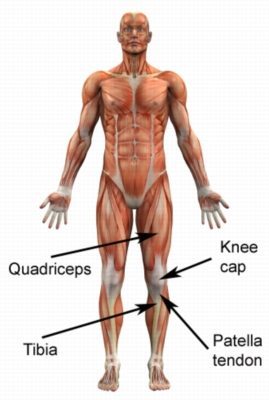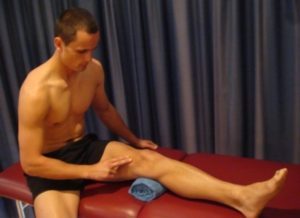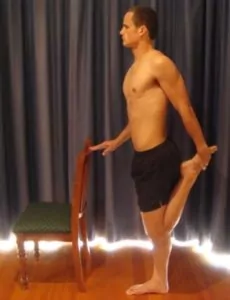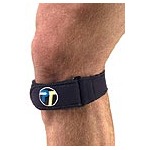Sinding-Larsen-Johansson Disease
Updated:
(Also known as Sinding-Larsen-Johansson Syndrome, Distal Patella Apophysitis)
What is Sinding-Larsen-Johansson disease?
Sinding-Larsen-Johansson disease is a relatively uncommon condition of the knee affecting adolescents. It is an injury which causes irritation and inflammation to the bony growth plate at the bottom of the knee cap (patella) where the patella tendon attaches (figure 1).

The muscle group at the front of your thigh is called the quadriceps. The quadriceps attaches to the knee cap (patella), which in turn attaches to the top of the shin bone (tibia) via the patella tendon (figure 1).
In people who have not reached skeletal maturity, a growth plate exists where the patella tendon attaches to the patella (knee cap). This growth plate is primarily comprised of cartilage. Every time the quadriceps contracts, it pulls on the patella tendon which in turn pulls on the patella’s growth plate. When this tension is too forceful or repetitive, irritation to the growth plate may occur resulting in pain. This condition is called Sinding-Larsen-Johansson disease.
Causes of Sinding-Larsen-Johansson disease
Sinding-Larsen-Johansson disease is typically seen in children or adolescents during periods of rapid growth. This is because muscles and tendons become tighter as bones grow longer. As a result, more tension is placed on the patella’s growth plate. Sinding-Larsen-Johansson disease is more commonly seen in active children or adolescents who participate in activities requiring strong or repetitive quadriceps contractions such as running or jumping sports.
Signs and symptoms of Sinding-Larsen-Johansson disease
Patients with this condition typically experience pain at the front of the knee which is focused at the bottom of the knee cap (the apex of the patella). The pain associated with Sinding-Larsen-Johansson disease may increase during activities requiring strong quadriceps contractions such as squatting, going up and down stairs, running (especially uphill), jumping or hopping. Patients may also experience pain when kneeling or placing firm pressure to the bottom of the knee cap. An increased or swollen bony prominence may also be detected at the bottom of the knee cap, coinciding with the source of pain in patients with this condition.
Diagnosis of Sinding-Larsen-Johansson disease
A thorough subjective and objective examination from a physiotherapist is usually sufficient to diagnose Sinding-Larsen-Johansson disease. Investigations such as an X-ray, MRI scan or CT scan may be required occasionally to confirm diagnosis.
Treatment for Sinding-Larsen-Johansson disease
Most patients with this condition heal well with appropriate physiotherapy. The success rate of treatment is largely dictated by patient compliance. A vital aspect of treatment is that the patient rests from any activity that increases their pain. Activities placing large amounts of stress on the patella should also be minimized, particularly squatting, sprinting, jumping and hopping. Resting from aggravating activities ensures the body can begin the healing process in the absence of further damage. Once the patient can perform these activities pain free a gradual return to these activities is indicated provided there is no increase in symptoms.
Ignoring symptoms or adopting a ‘no pain, no gain’ attitude is likely to cause further damage and prolong recovery. Immediate, appropriate treatment in patients with this condition is essential to ensure a speedy recovery.
Whether or not a patient with this condition should continue playing sport is dependent on symptoms. Patients with mild symptoms may wish to continue to play some or all sport, others may choose to modify their program. Generally it is recommended that patients keep active provided their symptoms are mild or absent.
Patients with Sinding-Larsen-Johansson disease should follow the R.I.C.E. Regime in the initial phase of injury. The R.I.C.E regime is beneficial in the first 72 hours following symptom onset or when inflammatory signs are present (i.e. morning pain or pain with rest). The R.I.C.E. regime involves resting from aggravating activities (this may include the use of crutches), regular icing, the use of a compression bandage and keeping the leg elevated. Anti-inflammatory medication may also hasten the healing process by reducing the pain and swelling associated with inflammation.
Patients with this condition should perform pain-free flexibility and strengthening exercises as part of their rehabilitation to ensure an optimal outcome. Emphasis is often placed on stretching of the quadriceps muscles. The treating physiotherapist can advise which exercises are most appropriate for the patient and when they should be commenced.
Prognosis of Sinding-Larsen-Johansson disease
Sinding-Larsen-Johansson disease is a self limiting condition that gradually resolves as the patient moves towards skeletal maturity. This usually takes between 6 to 12 months but may persist for as long as 2 years. With appropriate management, symptoms typically improve gradually over time and full function is restored. Sinding-Larsen-Johansson disease does not interfere with growth.
Contributing factors to the development of Sinding-Larsen-Johansson disease
There are several factors which may increase the likelihood of developing this condition. These need to be assessed and corrected where possible, with direction from a physiotherapist to ensure an optimal outcome. Some of the factors which may contribute to the development of this condition include:
- a sudden increase in training or sporting activity
- inappropriate training
- recent growth spurts
- inappropriate footwear
- muscle tightness or weakness (particularly the quadriceps)
- joint stiffness
- poor lower limb biomechanics
- poor foot posture
Physiotherapy for Sinding-Larsen-Johansson disease
Physiotherapy treatment for patients with this condition is vital to hasten the healing process, reduce pain and allow for increased activity levels. Treatment may comprise:
- soft tissue massage
- stretches
- electrotherapy
- icing
- taping or bracing
- the use of crutches
- biomechanical correction
- education
- activity modification advice
- exercises to address any flexibility, strength or balance issues
- a gradual return to activity program
Other intervention for Sinding-Larsen-Johansson disease
A consultation with a podiatrist may be indicated occasionally in patients with this condition to improve their outcome. The treating physiotherapist can advise if this is required.
Exercises for Sinding-Larsen-Johansson disease
The following exercises are commonly prescribed to patients with this condition. You should discuss the suitability of these exercises with your physiotherapist prior to beginning them. Generally, they should be performed 3 times daily and only provided they do not cause or increase symptoms.
Static Quadriceps Contraction
Begin this exercise by sitting with your leg straight in front of you (figure 2). Tighten the muscle at the front of your thigh (quadriceps) by pushing your knee down into a towel. Put your fingers on your inner quadriceps to feel the muscle tighten during contraction. Hold for 5 seconds and repeat 10 times as hard as possible pain free.

Quadriceps Stretch
Begin this exercise for by holding a chair or table for balance. Take your heel towards your bottom, keeping your knees together and your back straight until you feel a gentle stretch in the front of your thigh or as far as you can go without pain. Hold for 15 seconds, 4 times at a mild to moderate stretch pain-free.

Find a Physio for Sinding-Larsen-Johansson disease
Find a physiotherapist in your local area to treat this condition.
Other Exercises
- View more Knee Strengthening Exercises.
- View more Knee Flexibility Exercises.
Physiotherapy products for Sinding-Larsen-Johansson disease
Some of the most commonly recommended products by physiotherapists to hasten healing and speed recovery in patients with this condition include:
To purchase physiotherapy products for Sinding-Larsen-Johansson disease click on one of the above links or visit the PhysioAdvisor Shop.

Link to this Page
If you would like to link to this article on your website, simply copy the code below and add it to your page:
<a href="https://physioadvisor.com.au/injuries/knee/sindinglarsenjohansson-disease”>Sinding-Larsen-Johansson Disease – PhysioAdvisor.com</a><br/>PhysioAdvisor offers expert physiotherapy information on Sinding-Larsen-Johansson disease including: diagnosis, treatment, exercises, physiotherapy products and more...
Return to the top of Sinding-Larsen-Johansson Disease.




